Employee Engagement: Importance for Individuals and Organizations
VerifiedAdded on 2023/06/03
|11
|3112
|387
Essay
AI Summary
This essay delves into the critical role of employee engagement within organizations, examining its multifaceted importance for both individual employees and the overall success of the company. The introduction defines employee engagement as a strategic approach to foster employee commitment and dedication, setting the stage for a comprehensive analysis. The essay then explores how employee engagement enhances workplace safety, employee health, and well-being, including reducing accidents and promoting healthier lifestyles through various corporate policies. Furthermore, the essay highlights the positive impact of engagement on organizational profitability, sales, and employee retention, and also examines the factors that contribute to successful employee engagement initiatives, such as career development, flexible schedules, fair pay, and open communication. The conclusion reinforces the significance of employee engagement as a crucial strategy for fostering a productive, healthy, and successful work environment.

Human Resource Management
Paraphrase This Document
Need a fresh take? Get an instant paraphrase of this document with our AI Paraphraser

P a g e | 1
Table of Contents
Introduction............................................................................................................................ 2
Employee Engagement..........................................................................................................3
Importance of Employee Engagement...................................................................................3
Conclusion............................................................................................................................. 7
References............................................................................................................................. 8
Table of Contents
Introduction............................................................................................................................ 2
Employee Engagement..........................................................................................................3
Importance of Employee Engagement...................................................................................3
Conclusion............................................................................................................................. 7
References............................................................................................................................. 8
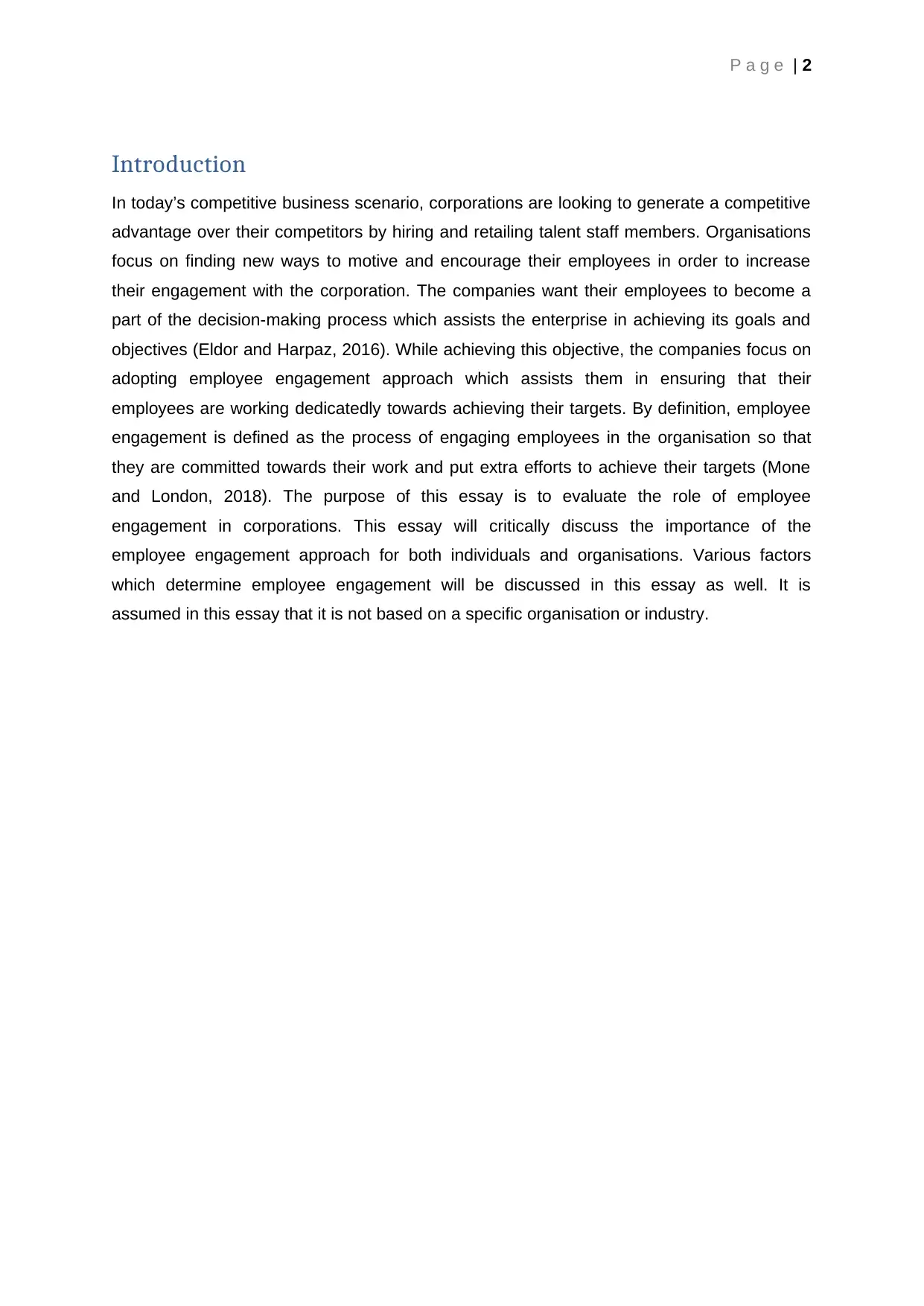
P a g e | 2
Introduction
In today’s competitive business scenario, corporations are looking to generate a competitive
advantage over their competitors by hiring and retailing talent staff members. Organisations
focus on finding new ways to motive and encourage their employees in order to increase
their engagement with the corporation. The companies want their employees to become a
part of the decision-making process which assists the enterprise in achieving its goals and
objectives (Eldor and Harpaz, 2016). While achieving this objective, the companies focus on
adopting employee engagement approach which assists them in ensuring that their
employees are working dedicatedly towards achieving their targets. By definition, employee
engagement is defined as the process of engaging employees in the organisation so that
they are committed towards their work and put extra efforts to achieve their targets (Mone
and London, 2018). The purpose of this essay is to evaluate the role of employee
engagement in corporations. This essay will critically discuss the importance of the
employee engagement approach for both individuals and organisations. Various factors
which determine employee engagement will be discussed in this essay as well. It is
assumed in this essay that it is not based on a specific organisation or industry.
Introduction
In today’s competitive business scenario, corporations are looking to generate a competitive
advantage over their competitors by hiring and retailing talent staff members. Organisations
focus on finding new ways to motive and encourage their employees in order to increase
their engagement with the corporation. The companies want their employees to become a
part of the decision-making process which assists the enterprise in achieving its goals and
objectives (Eldor and Harpaz, 2016). While achieving this objective, the companies focus on
adopting employee engagement approach which assists them in ensuring that their
employees are working dedicatedly towards achieving their targets. By definition, employee
engagement is defined as the process of engaging employees in the organisation so that
they are committed towards their work and put extra efforts to achieve their targets (Mone
and London, 2018). The purpose of this essay is to evaluate the role of employee
engagement in corporations. This essay will critically discuss the importance of the
employee engagement approach for both individuals and organisations. Various factors
which determine employee engagement will be discussed in this essay as well. It is
assumed in this essay that it is not based on a specific organisation or industry.
⊘ This is a preview!⊘
Do you want full access?
Subscribe today to unlock all pages.

Trusted by 1+ million students worldwide
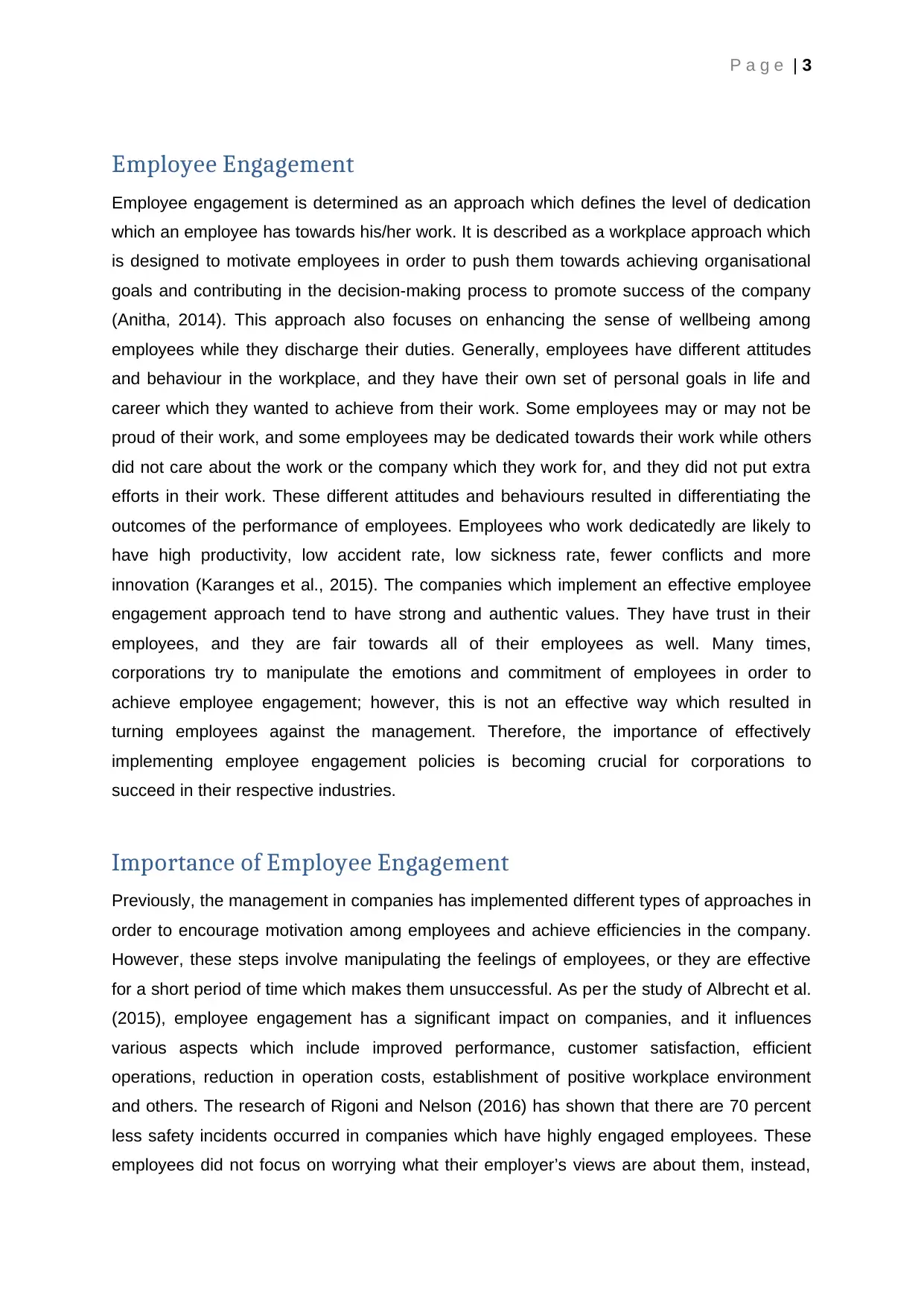
P a g e | 3
Employee Engagement
Employee engagement is determined as an approach which defines the level of dedication
which an employee has towards his/her work. It is described as a workplace approach which
is designed to motivate employees in order to push them towards achieving organisational
goals and contributing in the decision-making process to promote success of the company
(Anitha, 2014). This approach also focuses on enhancing the sense of wellbeing among
employees while they discharge their duties. Generally, employees have different attitudes
and behaviour in the workplace, and they have their own set of personal goals in life and
career which they wanted to achieve from their work. Some employees may or may not be
proud of their work, and some employees may be dedicated towards their work while others
did not care about the work or the company which they work for, and they did not put extra
efforts in their work. These different attitudes and behaviours resulted in differentiating the
outcomes of the performance of employees. Employees who work dedicatedly are likely to
have high productivity, low accident rate, low sickness rate, fewer conflicts and more
innovation (Karanges et al., 2015). The companies which implement an effective employee
engagement approach tend to have strong and authentic values. They have trust in their
employees, and they are fair towards all of their employees as well. Many times,
corporations try to manipulate the emotions and commitment of employees in order to
achieve employee engagement; however, this is not an effective way which resulted in
turning employees against the management. Therefore, the importance of effectively
implementing employee engagement policies is becoming crucial for corporations to
succeed in their respective industries.
Importance of Employee Engagement
Previously, the management in companies has implemented different types of approaches in
order to encourage motivation among employees and achieve efficiencies in the company.
However, these steps involve manipulating the feelings of employees, or they are effective
for a short period of time which makes them unsuccessful. As per the study of Albrecht et al.
(2015), employee engagement has a significant impact on companies, and it influences
various aspects which include improved performance, customer satisfaction, efficient
operations, reduction in operation costs, establishment of positive workplace environment
and others. The research of Rigoni and Nelson (2016) has shown that there are 70 percent
less safety incidents occurred in companies which have highly engaged employees. These
employees did not focus on worrying what their employer’s views are about them, instead,
Employee Engagement
Employee engagement is determined as an approach which defines the level of dedication
which an employee has towards his/her work. It is described as a workplace approach which
is designed to motivate employees in order to push them towards achieving organisational
goals and contributing in the decision-making process to promote success of the company
(Anitha, 2014). This approach also focuses on enhancing the sense of wellbeing among
employees while they discharge their duties. Generally, employees have different attitudes
and behaviour in the workplace, and they have their own set of personal goals in life and
career which they wanted to achieve from their work. Some employees may or may not be
proud of their work, and some employees may be dedicated towards their work while others
did not care about the work or the company which they work for, and they did not put extra
efforts in their work. These different attitudes and behaviours resulted in differentiating the
outcomes of the performance of employees. Employees who work dedicatedly are likely to
have high productivity, low accident rate, low sickness rate, fewer conflicts and more
innovation (Karanges et al., 2015). The companies which implement an effective employee
engagement approach tend to have strong and authentic values. They have trust in their
employees, and they are fair towards all of their employees as well. Many times,
corporations try to manipulate the emotions and commitment of employees in order to
achieve employee engagement; however, this is not an effective way which resulted in
turning employees against the management. Therefore, the importance of effectively
implementing employee engagement policies is becoming crucial for corporations to
succeed in their respective industries.
Importance of Employee Engagement
Previously, the management in companies has implemented different types of approaches in
order to encourage motivation among employees and achieve efficiencies in the company.
However, these steps involve manipulating the feelings of employees, or they are effective
for a short period of time which makes them unsuccessful. As per the study of Albrecht et al.
(2015), employee engagement has a significant impact on companies, and it influences
various aspects which include improved performance, customer satisfaction, efficient
operations, reduction in operation costs, establishment of positive workplace environment
and others. The research of Rigoni and Nelson (2016) has shown that there are 70 percent
less safety incidents occurred in companies which have highly engaged employees. These
employees did not focus on worrying what their employer’s views are about them, instead,
Paraphrase This Document
Need a fresh take? Get an instant paraphrase of this document with our AI Paraphraser
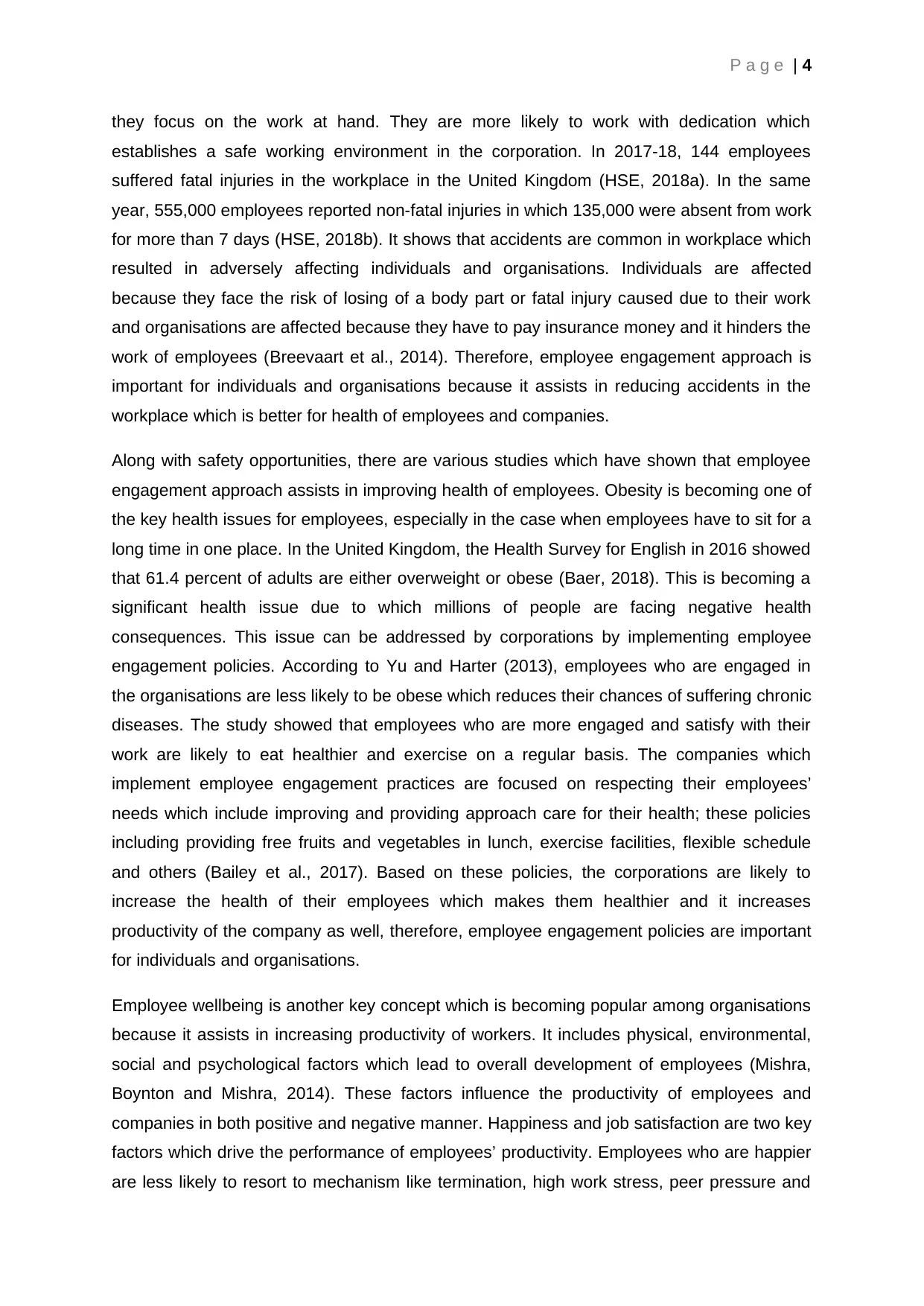
P a g e | 4
they focus on the work at hand. They are more likely to work with dedication which
establishes a safe working environment in the corporation. In 2017-18, 144 employees
suffered fatal injuries in the workplace in the United Kingdom (HSE, 2018a). In the same
year, 555,000 employees reported non-fatal injuries in which 135,000 were absent from work
for more than 7 days (HSE, 2018b). It shows that accidents are common in workplace which
resulted in adversely affecting individuals and organisations. Individuals are affected
because they face the risk of losing of a body part or fatal injury caused due to their work
and organisations are affected because they have to pay insurance money and it hinders the
work of employees (Breevaart et al., 2014). Therefore, employee engagement approach is
important for individuals and organisations because it assists in reducing accidents in the
workplace which is better for health of employees and companies.
Along with safety opportunities, there are various studies which have shown that employee
engagement approach assists in improving health of employees. Obesity is becoming one of
the key health issues for employees, especially in the case when employees have to sit for a
long time in one place. In the United Kingdom, the Health Survey for English in 2016 showed
that 61.4 percent of adults are either overweight or obese (Baer, 2018). This is becoming a
significant health issue due to which millions of people are facing negative health
consequences. This issue can be addressed by corporations by implementing employee
engagement policies. According to Yu and Harter (2013), employees who are engaged in
the organisations are less likely to be obese which reduces their chances of suffering chronic
diseases. The study showed that employees who are more engaged and satisfy with their
work are likely to eat healthier and exercise on a regular basis. The companies which
implement employee engagement practices are focused on respecting their employees’
needs which include improving and providing approach care for their health; these policies
including providing free fruits and vegetables in lunch, exercise facilities, flexible schedule
and others (Bailey et al., 2017). Based on these policies, the corporations are likely to
increase the health of their employees which makes them healthier and it increases
productivity of the company as well, therefore, employee engagement policies are important
for individuals and organisations.
Employee wellbeing is another key concept which is becoming popular among organisations
because it assists in increasing productivity of workers. It includes physical, environmental,
social and psychological factors which lead to overall development of employees (Mishra,
Boynton and Mishra, 2014). These factors influence the productivity of employees and
companies in both positive and negative manner. Happiness and job satisfaction are two key
factors which drive the performance of employees’ productivity. Employees who are happier
are less likely to resort to mechanism like termination, high work stress, peer pressure and
they focus on the work at hand. They are more likely to work with dedication which
establishes a safe working environment in the corporation. In 2017-18, 144 employees
suffered fatal injuries in the workplace in the United Kingdom (HSE, 2018a). In the same
year, 555,000 employees reported non-fatal injuries in which 135,000 were absent from work
for more than 7 days (HSE, 2018b). It shows that accidents are common in workplace which
resulted in adversely affecting individuals and organisations. Individuals are affected
because they face the risk of losing of a body part or fatal injury caused due to their work
and organisations are affected because they have to pay insurance money and it hinders the
work of employees (Breevaart et al., 2014). Therefore, employee engagement approach is
important for individuals and organisations because it assists in reducing accidents in the
workplace which is better for health of employees and companies.
Along with safety opportunities, there are various studies which have shown that employee
engagement approach assists in improving health of employees. Obesity is becoming one of
the key health issues for employees, especially in the case when employees have to sit for a
long time in one place. In the United Kingdom, the Health Survey for English in 2016 showed
that 61.4 percent of adults are either overweight or obese (Baer, 2018). This is becoming a
significant health issue due to which millions of people are facing negative health
consequences. This issue can be addressed by corporations by implementing employee
engagement policies. According to Yu and Harter (2013), employees who are engaged in
the organisations are less likely to be obese which reduces their chances of suffering chronic
diseases. The study showed that employees who are more engaged and satisfy with their
work are likely to eat healthier and exercise on a regular basis. The companies which
implement employee engagement practices are focused on respecting their employees’
needs which include improving and providing approach care for their health; these policies
including providing free fruits and vegetables in lunch, exercise facilities, flexible schedule
and others (Bailey et al., 2017). Based on these policies, the corporations are likely to
increase the health of their employees which makes them healthier and it increases
productivity of the company as well, therefore, employee engagement policies are important
for individuals and organisations.
Employee wellbeing is another key concept which is becoming popular among organisations
because it assists in increasing productivity of workers. It includes physical, environmental,
social and psychological factors which lead to overall development of employees (Mishra,
Boynton and Mishra, 2014). These factors influence the productivity of employees and
companies in both positive and negative manner. Happiness and job satisfaction are two key
factors which drive the performance of employees’ productivity. Employees who are happier
are less likely to resort to mechanism like termination, high work stress, peer pressure and
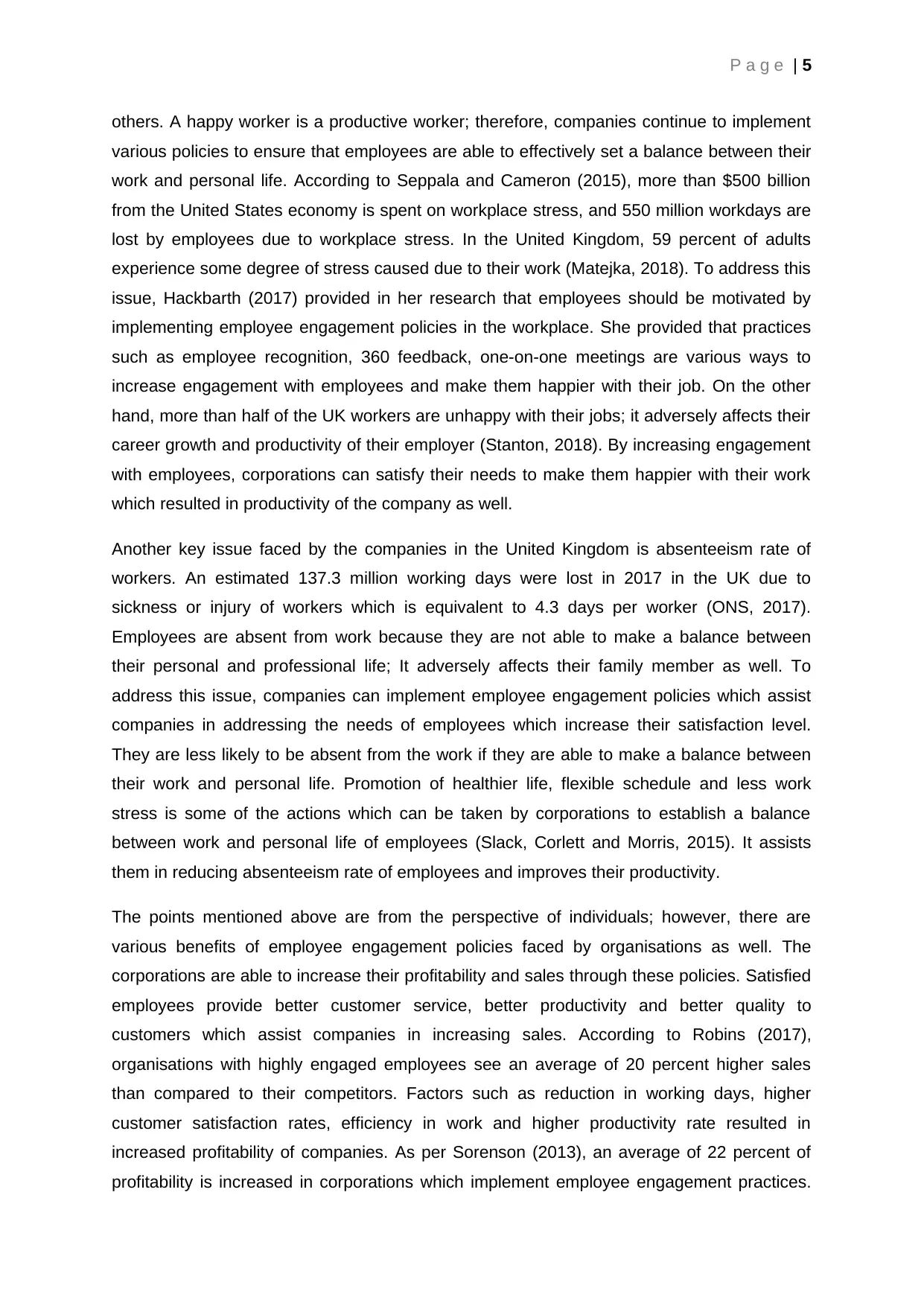
P a g e | 5
others. A happy worker is a productive worker; therefore, companies continue to implement
various policies to ensure that employees are able to effectively set a balance between their
work and personal life. According to Seppala and Cameron (2015), more than $500 billion
from the United States economy is spent on workplace stress, and 550 million workdays are
lost by employees due to workplace stress. In the United Kingdom, 59 percent of adults
experience some degree of stress caused due to their work (Matejka, 2018). To address this
issue, Hackbarth (2017) provided in her research that employees should be motivated by
implementing employee engagement policies in the workplace. She provided that practices
such as employee recognition, 360 feedback, one-on-one meetings are various ways to
increase engagement with employees and make them happier with their job. On the other
hand, more than half of the UK workers are unhappy with their jobs; it adversely affects their
career growth and productivity of their employer (Stanton, 2018). By increasing engagement
with employees, corporations can satisfy their needs to make them happier with their work
which resulted in productivity of the company as well.
Another key issue faced by the companies in the United Kingdom is absenteeism rate of
workers. An estimated 137.3 million working days were lost in 2017 in the UK due to
sickness or injury of workers which is equivalent to 4.3 days per worker (ONS, 2017).
Employees are absent from work because they are not able to make a balance between
their personal and professional life; It adversely affects their family member as well. To
address this issue, companies can implement employee engagement policies which assist
companies in addressing the needs of employees which increase their satisfaction level.
They are less likely to be absent from the work if they are able to make a balance between
their work and personal life. Promotion of healthier life, flexible schedule and less work
stress is some of the actions which can be taken by corporations to establish a balance
between work and personal life of employees (Slack, Corlett and Morris, 2015). It assists
them in reducing absenteeism rate of employees and improves their productivity.
The points mentioned above are from the perspective of individuals; however, there are
various benefits of employee engagement policies faced by organisations as well. The
corporations are able to increase their profitability and sales through these policies. Satisfied
employees provide better customer service, better productivity and better quality to
customers which assist companies in increasing sales. According to Robins (2017),
organisations with highly engaged employees see an average of 20 percent higher sales
than compared to their competitors. Factors such as reduction in working days, higher
customer satisfaction rates, efficiency in work and higher productivity rate resulted in
increased profitability of companies. As per Sorenson (2013), an average of 22 percent of
profitability is increased in corporations which implement employee engagement practices.
others. A happy worker is a productive worker; therefore, companies continue to implement
various policies to ensure that employees are able to effectively set a balance between their
work and personal life. According to Seppala and Cameron (2015), more than $500 billion
from the United States economy is spent on workplace stress, and 550 million workdays are
lost by employees due to workplace stress. In the United Kingdom, 59 percent of adults
experience some degree of stress caused due to their work (Matejka, 2018). To address this
issue, Hackbarth (2017) provided in her research that employees should be motivated by
implementing employee engagement policies in the workplace. She provided that practices
such as employee recognition, 360 feedback, one-on-one meetings are various ways to
increase engagement with employees and make them happier with their job. On the other
hand, more than half of the UK workers are unhappy with their jobs; it adversely affects their
career growth and productivity of their employer (Stanton, 2018). By increasing engagement
with employees, corporations can satisfy their needs to make them happier with their work
which resulted in productivity of the company as well.
Another key issue faced by the companies in the United Kingdom is absenteeism rate of
workers. An estimated 137.3 million working days were lost in 2017 in the UK due to
sickness or injury of workers which is equivalent to 4.3 days per worker (ONS, 2017).
Employees are absent from work because they are not able to make a balance between
their personal and professional life; It adversely affects their family member as well. To
address this issue, companies can implement employee engagement policies which assist
companies in addressing the needs of employees which increase their satisfaction level.
They are less likely to be absent from the work if they are able to make a balance between
their work and personal life. Promotion of healthier life, flexible schedule and less work
stress is some of the actions which can be taken by corporations to establish a balance
between work and personal life of employees (Slack, Corlett and Morris, 2015). It assists
them in reducing absenteeism rate of employees and improves their productivity.
The points mentioned above are from the perspective of individuals; however, there are
various benefits of employee engagement policies faced by organisations as well. The
corporations are able to increase their profitability and sales through these policies. Satisfied
employees provide better customer service, better productivity and better quality to
customers which assist companies in increasing sales. According to Robins (2017),
organisations with highly engaged employees see an average of 20 percent higher sales
than compared to their competitors. Factors such as reduction in working days, higher
customer satisfaction rates, efficiency in work and higher productivity rate resulted in
increased profitability of companies. As per Sorenson (2013), an average of 22 percent of
profitability is increased in corporations which implement employee engagement practices.
⊘ This is a preview!⊘
Do you want full access?
Subscribe today to unlock all pages.

Trusted by 1+ million students worldwide
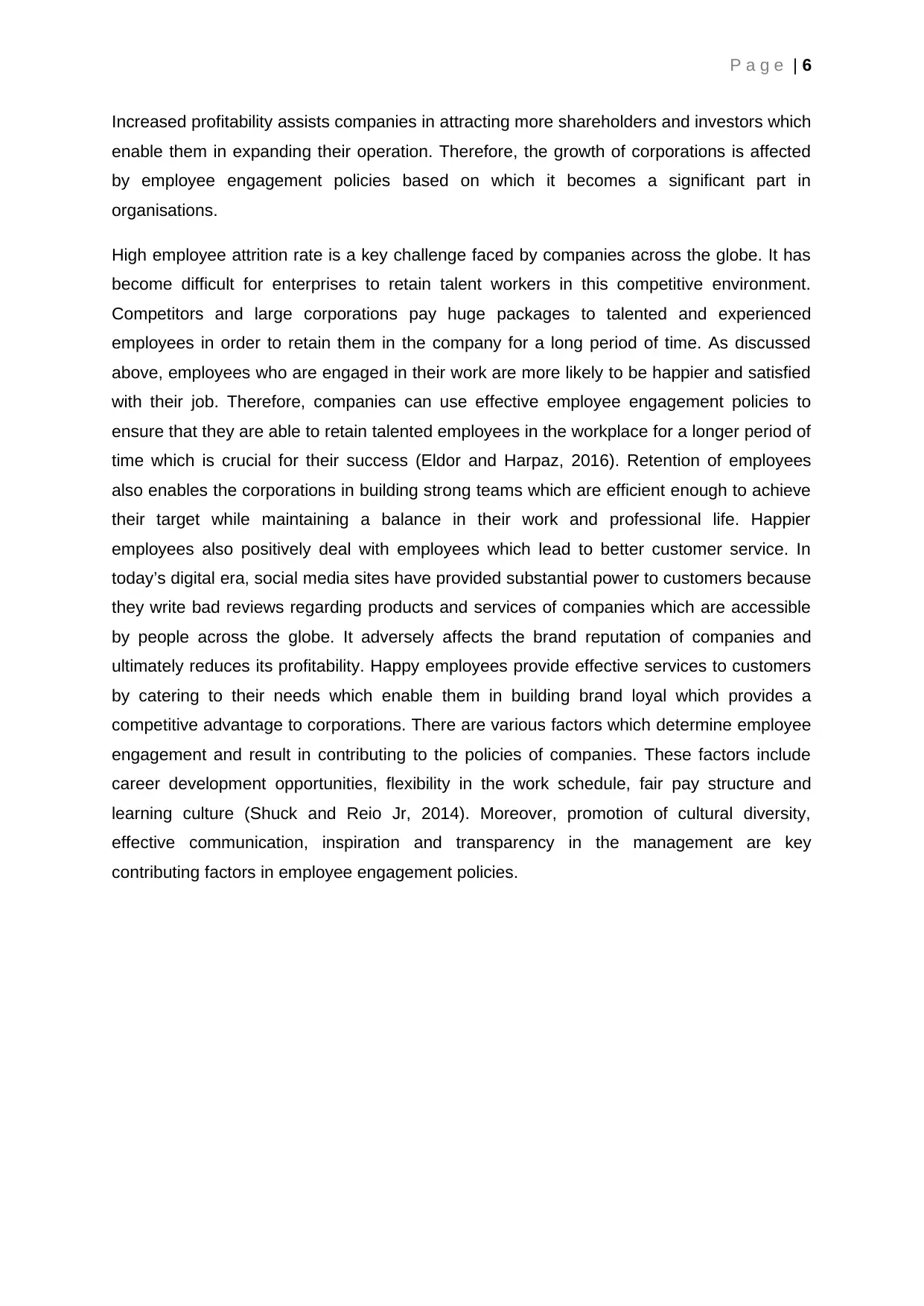
P a g e | 6
Increased profitability assists companies in attracting more shareholders and investors which
enable them in expanding their operation. Therefore, the growth of corporations is affected
by employee engagement policies based on which it becomes a significant part in
organisations.
High employee attrition rate is a key challenge faced by companies across the globe. It has
become difficult for enterprises to retain talent workers in this competitive environment.
Competitors and large corporations pay huge packages to talented and experienced
employees in order to retain them in the company for a long period of time. As discussed
above, employees who are engaged in their work are more likely to be happier and satisfied
with their job. Therefore, companies can use effective employee engagement policies to
ensure that they are able to retain talented employees in the workplace for a longer period of
time which is crucial for their success (Eldor and Harpaz, 2016). Retention of employees
also enables the corporations in building strong teams which are efficient enough to achieve
their target while maintaining a balance in their work and professional life. Happier
employees also positively deal with employees which lead to better customer service. In
today’s digital era, social media sites have provided substantial power to customers because
they write bad reviews regarding products and services of companies which are accessible
by people across the globe. It adversely affects the brand reputation of companies and
ultimately reduces its profitability. Happy employees provide effective services to customers
by catering to their needs which enable them in building brand loyal which provides a
competitive advantage to corporations. There are various factors which determine employee
engagement and result in contributing to the policies of companies. These factors include
career development opportunities, flexibility in the work schedule, fair pay structure and
learning culture (Shuck and Reio Jr, 2014). Moreover, promotion of cultural diversity,
effective communication, inspiration and transparency in the management are key
contributing factors in employee engagement policies.
Increased profitability assists companies in attracting more shareholders and investors which
enable them in expanding their operation. Therefore, the growth of corporations is affected
by employee engagement policies based on which it becomes a significant part in
organisations.
High employee attrition rate is a key challenge faced by companies across the globe. It has
become difficult for enterprises to retain talent workers in this competitive environment.
Competitors and large corporations pay huge packages to talented and experienced
employees in order to retain them in the company for a long period of time. As discussed
above, employees who are engaged in their work are more likely to be happier and satisfied
with their job. Therefore, companies can use effective employee engagement policies to
ensure that they are able to retain talented employees in the workplace for a longer period of
time which is crucial for their success (Eldor and Harpaz, 2016). Retention of employees
also enables the corporations in building strong teams which are efficient enough to achieve
their target while maintaining a balance in their work and professional life. Happier
employees also positively deal with employees which lead to better customer service. In
today’s digital era, social media sites have provided substantial power to customers because
they write bad reviews regarding products and services of companies which are accessible
by people across the globe. It adversely affects the brand reputation of companies and
ultimately reduces its profitability. Happy employees provide effective services to customers
by catering to their needs which enable them in building brand loyal which provides a
competitive advantage to corporations. There are various factors which determine employee
engagement and result in contributing to the policies of companies. These factors include
career development opportunities, flexibility in the work schedule, fair pay structure and
learning culture (Shuck and Reio Jr, 2014). Moreover, promotion of cultural diversity,
effective communication, inspiration and transparency in the management are key
contributing factors in employee engagement policies.
Paraphrase This Document
Need a fresh take? Get an instant paraphrase of this document with our AI Paraphraser
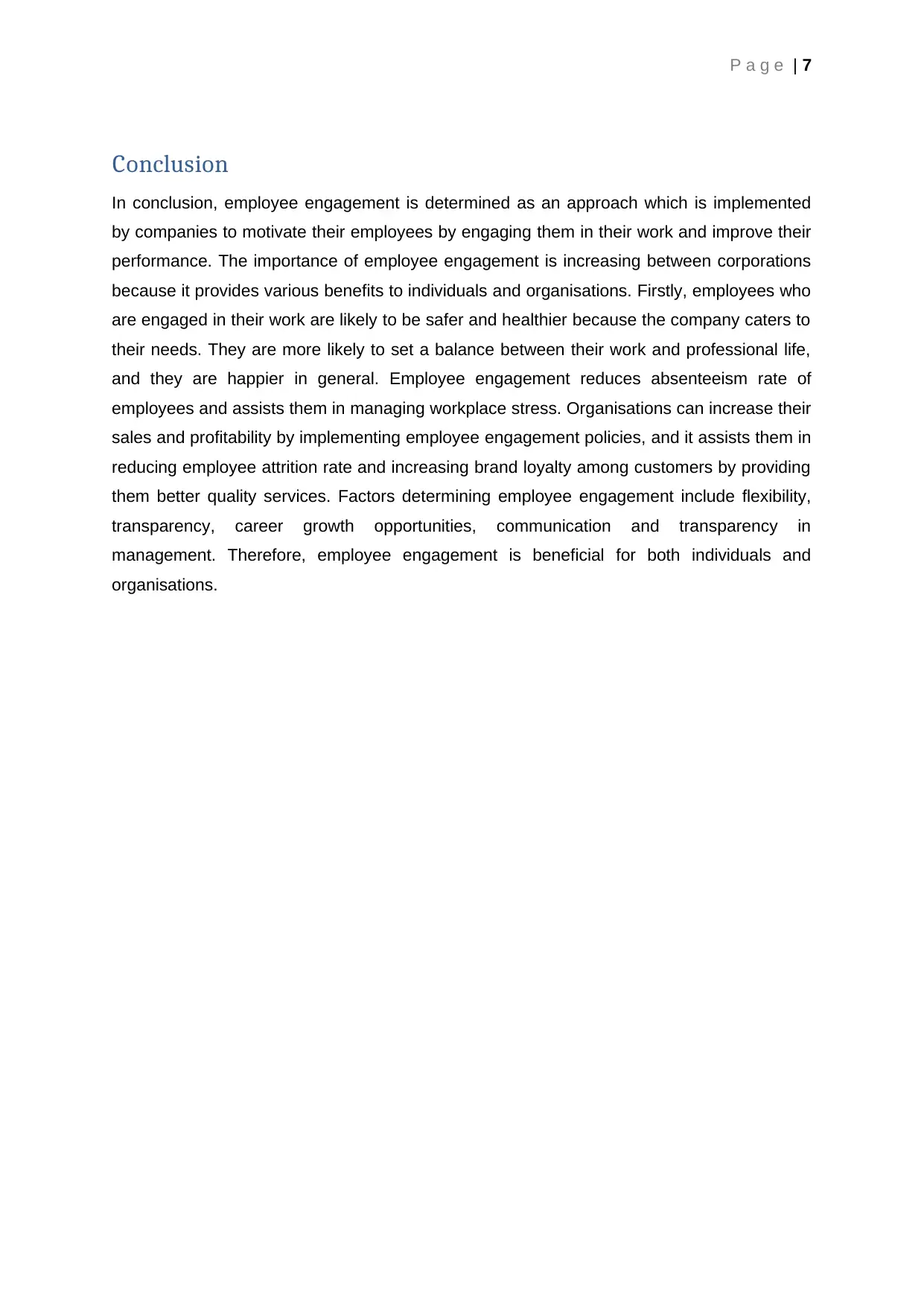
P a g e | 7
Conclusion
In conclusion, employee engagement is determined as an approach which is implemented
by companies to motivate their employees by engaging them in their work and improve their
performance. The importance of employee engagement is increasing between corporations
because it provides various benefits to individuals and organisations. Firstly, employees who
are engaged in their work are likely to be safer and healthier because the company caters to
their needs. They are more likely to set a balance between their work and professional life,
and they are happier in general. Employee engagement reduces absenteeism rate of
employees and assists them in managing workplace stress. Organisations can increase their
sales and profitability by implementing employee engagement policies, and it assists them in
reducing employee attrition rate and increasing brand loyalty among customers by providing
them better quality services. Factors determining employee engagement include flexibility,
transparency, career growth opportunities, communication and transparency in
management. Therefore, employee engagement is beneficial for both individuals and
organisations.
Conclusion
In conclusion, employee engagement is determined as an approach which is implemented
by companies to motivate their employees by engaging them in their work and improve their
performance. The importance of employee engagement is increasing between corporations
because it provides various benefits to individuals and organisations. Firstly, employees who
are engaged in their work are likely to be safer and healthier because the company caters to
their needs. They are more likely to set a balance between their work and professional life,
and they are happier in general. Employee engagement reduces absenteeism rate of
employees and assists them in managing workplace stress. Organisations can increase their
sales and profitability by implementing employee engagement policies, and it assists them in
reducing employee attrition rate and increasing brand loyalty among customers by providing
them better quality services. Factors determining employee engagement include flexibility,
transparency, career growth opportunities, communication and transparency in
management. Therefore, employee engagement is beneficial for both individuals and
organisations.
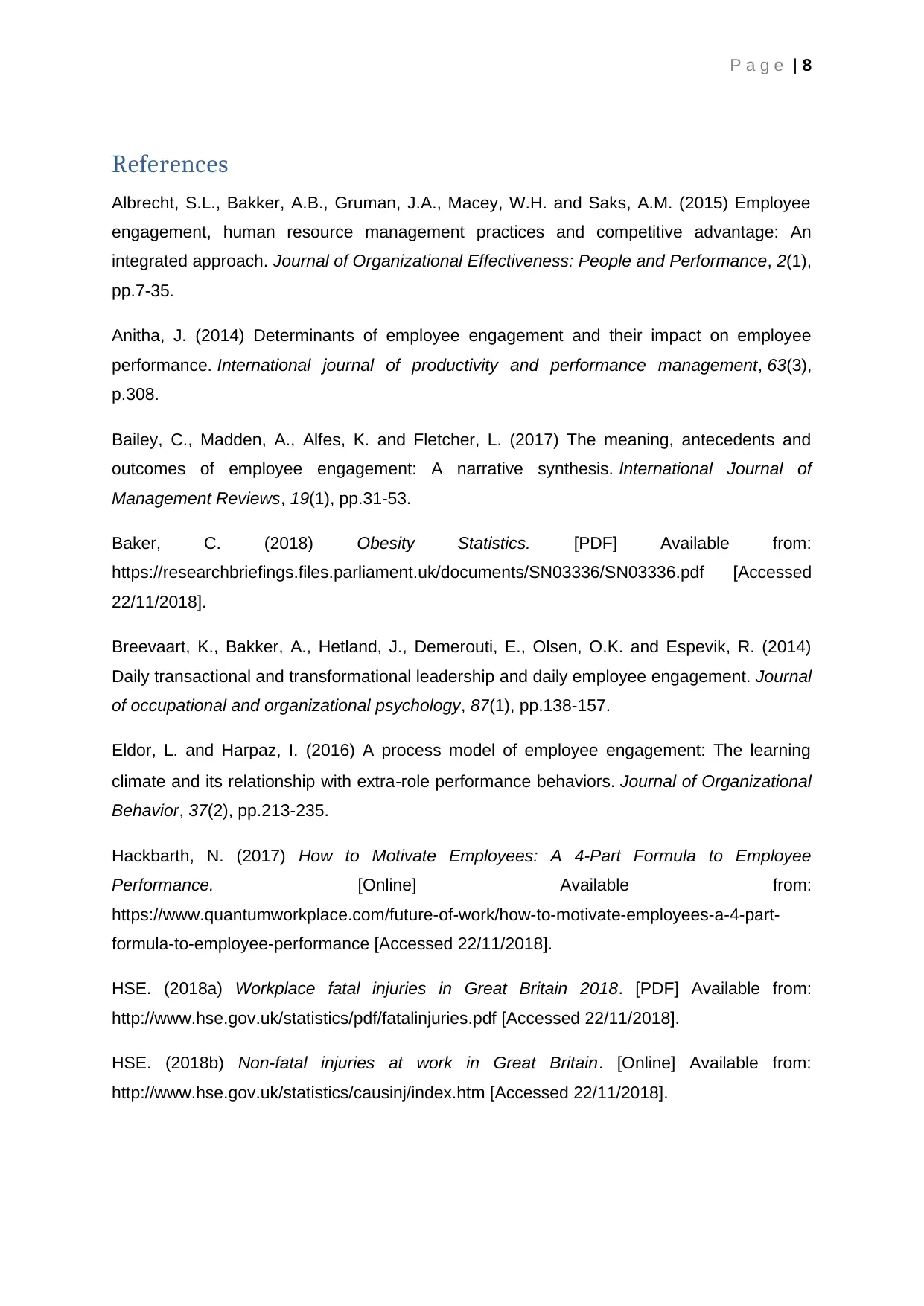
P a g e | 8
References
Albrecht, S.L., Bakker, A.B., Gruman, J.A., Macey, W.H. and Saks, A.M. (2015) Employee
engagement, human resource management practices and competitive advantage: An
integrated approach. Journal of Organizational Effectiveness: People and Performance, 2(1),
pp.7-35.
Anitha, J. (2014) Determinants of employee engagement and their impact on employee
performance. International journal of productivity and performance management, 63(3),
p.308.
Bailey, C., Madden, A., Alfes, K. and Fletcher, L. (2017) The meaning, antecedents and
outcomes of employee engagement: A narrative synthesis. International Journal of
Management Reviews, 19(1), pp.31-53.
Baker, C. (2018) Obesity Statistics. [PDF] Available from:
https://researchbriefings.files.parliament.uk/documents/SN03336/SN03336.pdf [Accessed
22/11/2018].
Breevaart, K., Bakker, A., Hetland, J., Demerouti, E., Olsen, O.K. and Espevik, R. (2014)
Daily transactional and transformational leadership and daily employee engagement. Journal
of occupational and organizational psychology, 87(1), pp.138-157.
Eldor, L. and Harpaz, I. (2016) A process model of employee engagement: The learning
climate and its relationship with extra‐role performance behaviors. Journal of Organizational
Behavior, 37(2), pp.213-235.
Hackbarth, N. (2017) How to Motivate Employees: A 4-Part Formula to Employee
Performance. [Online] Available from:
https://www.quantumworkplace.com/future-of-work/how-to-motivate-employees-a-4-part-
formula-to-employee-performance [Accessed 22/11/2018].
HSE. (2018a) Workplace fatal injuries in Great Britain 2018. [PDF] Available from:
http://www.hse.gov.uk/statistics/pdf/fatalinjuries.pdf [Accessed 22/11/2018].
HSE. (2018b) Non-fatal injuries at work in Great Britain. [Online] Available from:
http://www.hse.gov.uk/statistics/causinj/index.htm [Accessed 22/11/2018].
References
Albrecht, S.L., Bakker, A.B., Gruman, J.A., Macey, W.H. and Saks, A.M. (2015) Employee
engagement, human resource management practices and competitive advantage: An
integrated approach. Journal of Organizational Effectiveness: People and Performance, 2(1),
pp.7-35.
Anitha, J. (2014) Determinants of employee engagement and their impact on employee
performance. International journal of productivity and performance management, 63(3),
p.308.
Bailey, C., Madden, A., Alfes, K. and Fletcher, L. (2017) The meaning, antecedents and
outcomes of employee engagement: A narrative synthesis. International Journal of
Management Reviews, 19(1), pp.31-53.
Baker, C. (2018) Obesity Statistics. [PDF] Available from:
https://researchbriefings.files.parliament.uk/documents/SN03336/SN03336.pdf [Accessed
22/11/2018].
Breevaart, K., Bakker, A., Hetland, J., Demerouti, E., Olsen, O.K. and Espevik, R. (2014)
Daily transactional and transformational leadership and daily employee engagement. Journal
of occupational and organizational psychology, 87(1), pp.138-157.
Eldor, L. and Harpaz, I. (2016) A process model of employee engagement: The learning
climate and its relationship with extra‐role performance behaviors. Journal of Organizational
Behavior, 37(2), pp.213-235.
Hackbarth, N. (2017) How to Motivate Employees: A 4-Part Formula to Employee
Performance. [Online] Available from:
https://www.quantumworkplace.com/future-of-work/how-to-motivate-employees-a-4-part-
formula-to-employee-performance [Accessed 22/11/2018].
HSE. (2018a) Workplace fatal injuries in Great Britain 2018. [PDF] Available from:
http://www.hse.gov.uk/statistics/pdf/fatalinjuries.pdf [Accessed 22/11/2018].
HSE. (2018b) Non-fatal injuries at work in Great Britain. [Online] Available from:
http://www.hse.gov.uk/statistics/causinj/index.htm [Accessed 22/11/2018].
⊘ This is a preview!⊘
Do you want full access?
Subscribe today to unlock all pages.

Trusted by 1+ million students worldwide
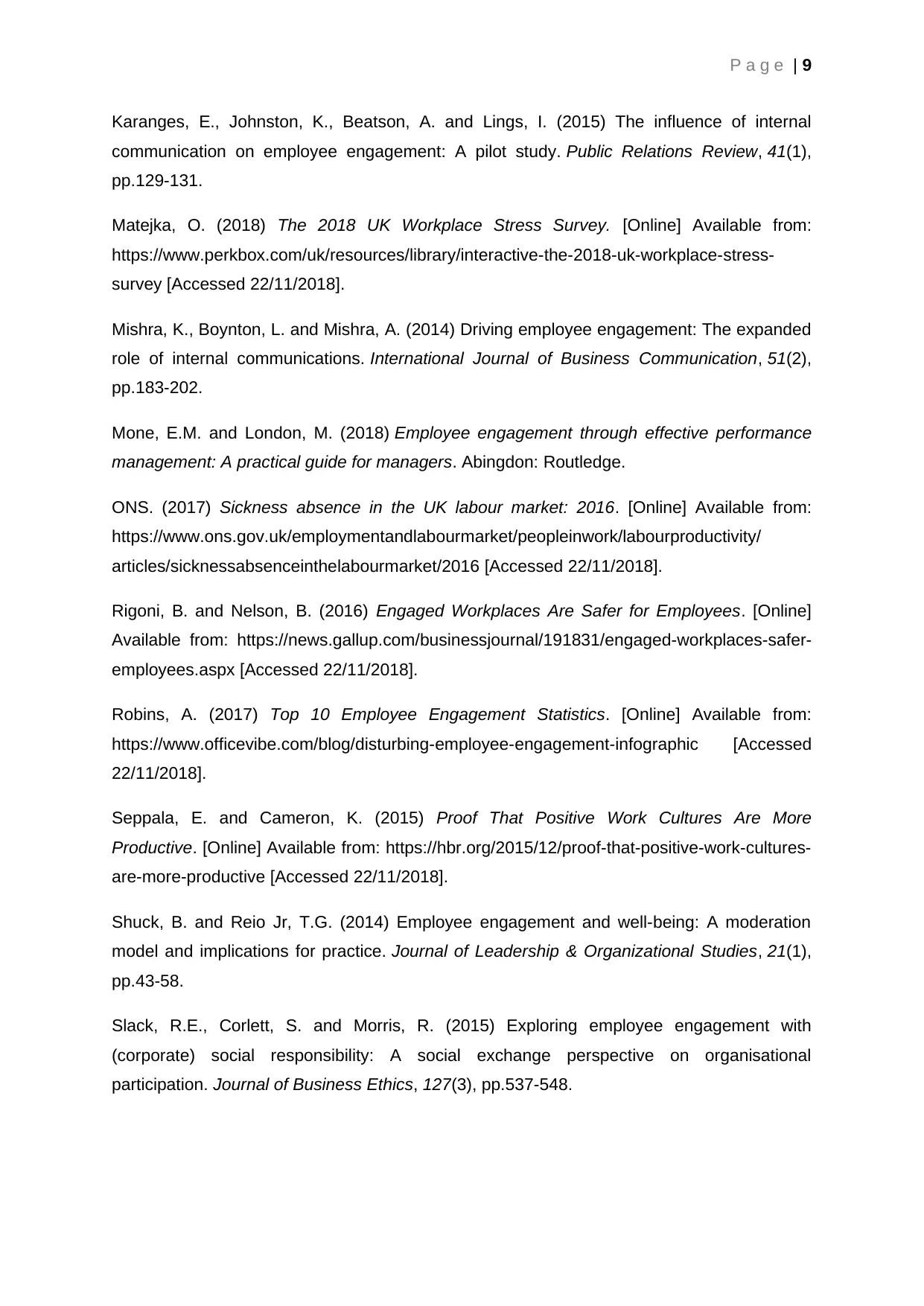
P a g e | 9
Karanges, E., Johnston, K., Beatson, A. and Lings, I. (2015) The influence of internal
communication on employee engagement: A pilot study. Public Relations Review, 41(1),
pp.129-131.
Matejka, O. (2018) The 2018 UK Workplace Stress Survey. [Online] Available from:
https://www.perkbox.com/uk/resources/library/interactive-the-2018-uk-workplace-stress-
survey [Accessed 22/11/2018].
Mishra, K., Boynton, L. and Mishra, A. (2014) Driving employee engagement: The expanded
role of internal communications. International Journal of Business Communication, 51(2),
pp.183-202.
Mone, E.M. and London, M. (2018) Employee engagement through effective performance
management: A practical guide for managers. Abingdon: Routledge.
ONS. (2017) Sickness absence in the UK labour market: 2016. [Online] Available from:
https://www.ons.gov.uk/employmentandlabourmarket/peopleinwork/labourproductivity/
articles/sicknessabsenceinthelabourmarket/2016 [Accessed 22/11/2018].
Rigoni, B. and Nelson, B. (2016) Engaged Workplaces Are Safer for Employees. [Online]
Available from: https://news.gallup.com/businessjournal/191831/engaged-workplaces-safer-
employees.aspx [Accessed 22/11/2018].
Robins, A. (2017) Top 10 Employee Engagement Statistics. [Online] Available from:
https://www.officevibe.com/blog/disturbing-employee-engagement-infographic [Accessed
22/11/2018].
Seppala, E. and Cameron, K. (2015) Proof That Positive Work Cultures Are More
Productive. [Online] Available from: https://hbr.org/2015/12/proof-that-positive-work-cultures-
are-more-productive [Accessed 22/11/2018].
Shuck, B. and Reio Jr, T.G. (2014) Employee engagement and well-being: A moderation
model and implications for practice. Journal of Leadership & Organizational Studies, 21(1),
pp.43-58.
Slack, R.E., Corlett, S. and Morris, R. (2015) Exploring employee engagement with
(corporate) social responsibility: A social exchange perspective on organisational
participation. Journal of Business Ethics, 127(3), pp.537-548.
Karanges, E., Johnston, K., Beatson, A. and Lings, I. (2015) The influence of internal
communication on employee engagement: A pilot study. Public Relations Review, 41(1),
pp.129-131.
Matejka, O. (2018) The 2018 UK Workplace Stress Survey. [Online] Available from:
https://www.perkbox.com/uk/resources/library/interactive-the-2018-uk-workplace-stress-
survey [Accessed 22/11/2018].
Mishra, K., Boynton, L. and Mishra, A. (2014) Driving employee engagement: The expanded
role of internal communications. International Journal of Business Communication, 51(2),
pp.183-202.
Mone, E.M. and London, M. (2018) Employee engagement through effective performance
management: A practical guide for managers. Abingdon: Routledge.
ONS. (2017) Sickness absence in the UK labour market: 2016. [Online] Available from:
https://www.ons.gov.uk/employmentandlabourmarket/peopleinwork/labourproductivity/
articles/sicknessabsenceinthelabourmarket/2016 [Accessed 22/11/2018].
Rigoni, B. and Nelson, B. (2016) Engaged Workplaces Are Safer for Employees. [Online]
Available from: https://news.gallup.com/businessjournal/191831/engaged-workplaces-safer-
employees.aspx [Accessed 22/11/2018].
Robins, A. (2017) Top 10 Employee Engagement Statistics. [Online] Available from:
https://www.officevibe.com/blog/disturbing-employee-engagement-infographic [Accessed
22/11/2018].
Seppala, E. and Cameron, K. (2015) Proof That Positive Work Cultures Are More
Productive. [Online] Available from: https://hbr.org/2015/12/proof-that-positive-work-cultures-
are-more-productive [Accessed 22/11/2018].
Shuck, B. and Reio Jr, T.G. (2014) Employee engagement and well-being: A moderation
model and implications for practice. Journal of Leadership & Organizational Studies, 21(1),
pp.43-58.
Slack, R.E., Corlett, S. and Morris, R. (2015) Exploring employee engagement with
(corporate) social responsibility: A social exchange perspective on organisational
participation. Journal of Business Ethics, 127(3), pp.537-548.
Paraphrase This Document
Need a fresh take? Get an instant paraphrase of this document with our AI Paraphraser
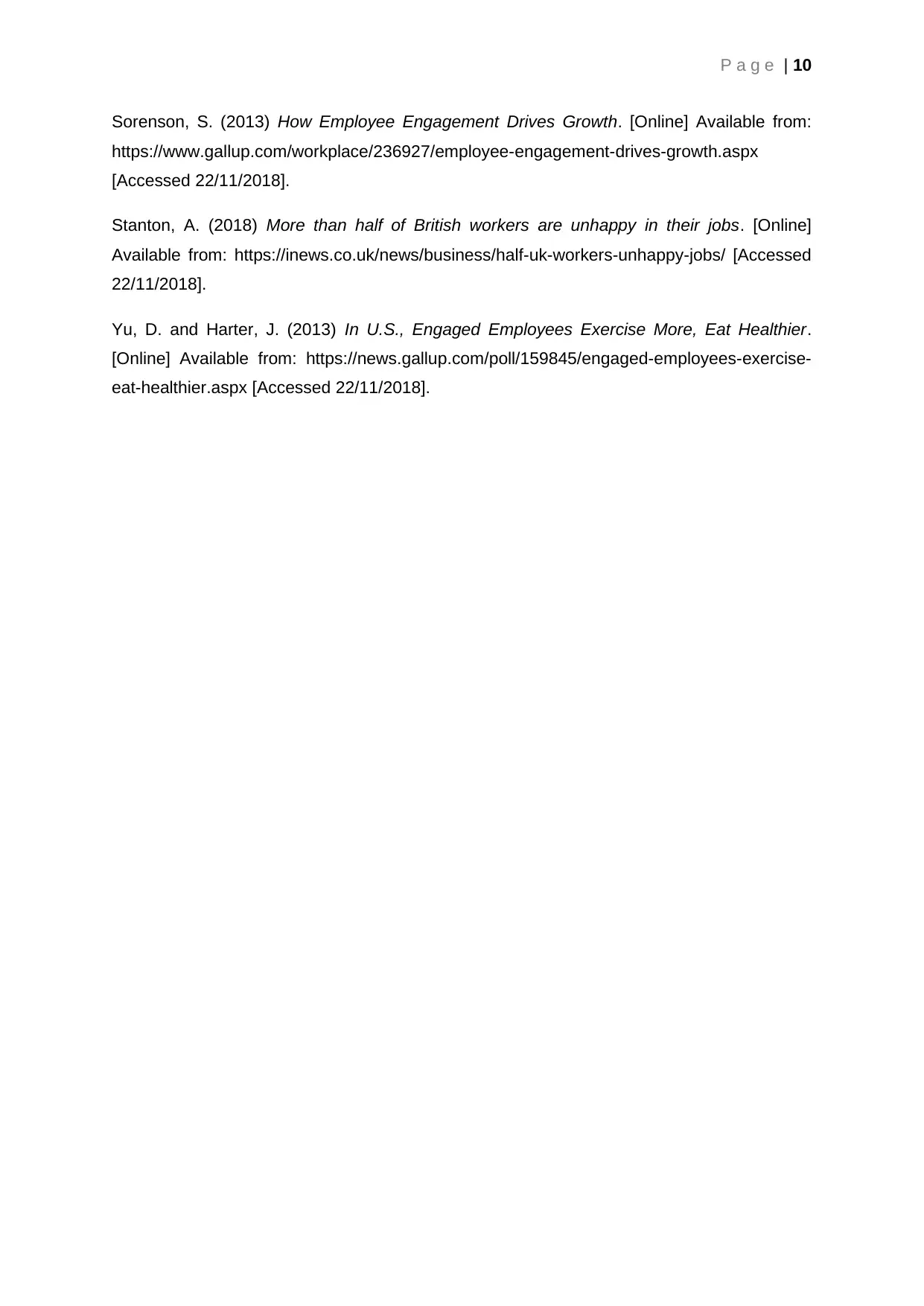
P a g e | 10
Sorenson, S. (2013) How Employee Engagement Drives Growth. [Online] Available from:
https://www.gallup.com/workplace/236927/employee-engagement-drives-growth.aspx
[Accessed 22/11/2018].
Stanton, A. (2018) More than half of British workers are unhappy in their jobs. [Online]
Available from: https://inews.co.uk/news/business/half-uk-workers-unhappy-jobs/ [Accessed
22/11/2018].
Yu, D. and Harter, J. (2013) In U.S., Engaged Employees Exercise More, Eat Healthier.
[Online] Available from: https://news.gallup.com/poll/159845/engaged-employees-exercise-
eat-healthier.aspx [Accessed 22/11/2018].
Sorenson, S. (2013) How Employee Engagement Drives Growth. [Online] Available from:
https://www.gallup.com/workplace/236927/employee-engagement-drives-growth.aspx
[Accessed 22/11/2018].
Stanton, A. (2018) More than half of British workers are unhappy in their jobs. [Online]
Available from: https://inews.co.uk/news/business/half-uk-workers-unhappy-jobs/ [Accessed
22/11/2018].
Yu, D. and Harter, J. (2013) In U.S., Engaged Employees Exercise More, Eat Healthier.
[Online] Available from: https://news.gallup.com/poll/159845/engaged-employees-exercise-
eat-healthier.aspx [Accessed 22/11/2018].
1 out of 11
Related Documents
Your All-in-One AI-Powered Toolkit for Academic Success.
+13062052269
info@desklib.com
Available 24*7 on WhatsApp / Email
![[object Object]](/_next/static/media/star-bottom.7253800d.svg)
Unlock your academic potential
Copyright © 2020–2025 A2Z Services. All Rights Reserved. Developed and managed by ZUCOL.





